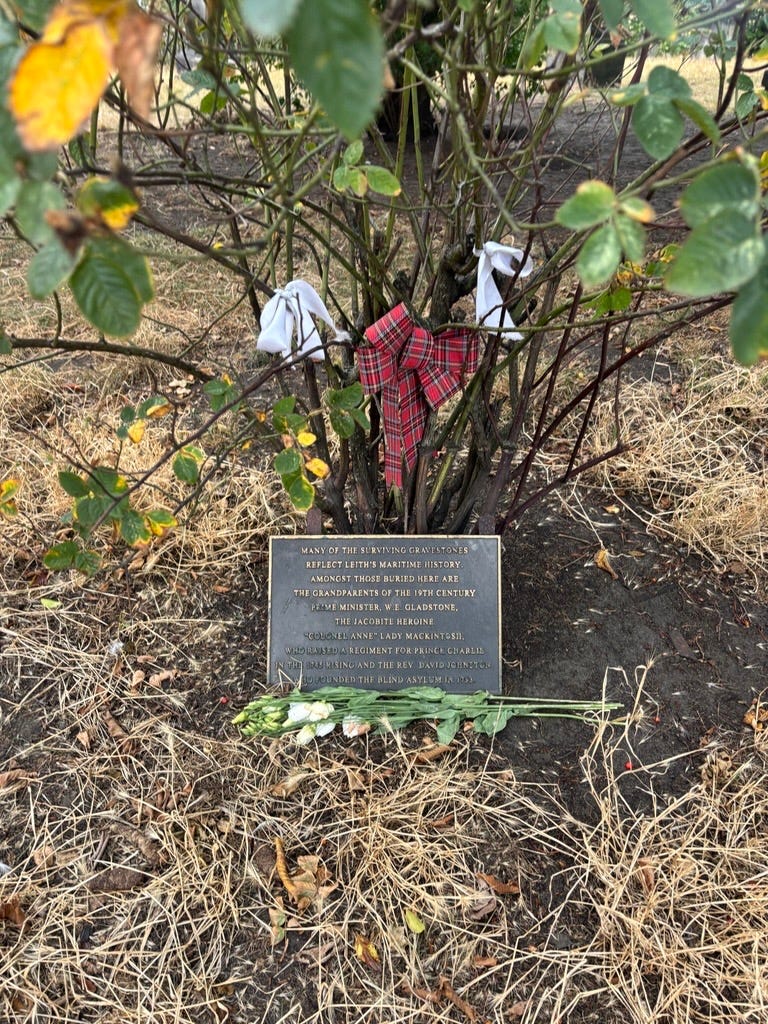Colonel Anne: The forgotten Jacobite heroine lying in an unmarked grave in Leith
Edinburgh is about to honour Elsie Inglis with a statue - but what about the remarkable women still forgotten?
When Edinburgh’s new statue of Scottish suffragist and maternal health pioneer Dr Elsie Inglis is unveiled on the Royal Mile, she will become the first woman to be immortalised on Scotland’s busiest street.
The decision has not come without debate; the design, by a male sculptor depicting Inglis in military dress, has sparked discussion on how best to represent her legacy. But beyond the controversy, it will mark long overdue progress in how Edinburgh remembers its women. If the city is finally beginning to give women their place in public memory, we should consider Anne Farquharson Mackintosh’s absence from the landscape, writes Jennevieve Collins.
Anne was a Jacobite, a prominent supporter of the Stuart cause in the Highlands, and known in her day as both Colonel Anne and ‘La Belle Rebelle.’ She famously saved the life of Bonnie Prince Charlie in a daring act of deception and defied her husband to rally hundreds of men for the rebel cause. Today, Mackintosh lies in North Leith Burial Ground, unmarked and almost forgotten.
Born in 1723 at Invercauld Castle near Braemar, Anne Farquharson was the daughter of a Highland laird. Her father, John Farquharson, was a Jacobite sympathiser who had fought in the 1715 Jacobite Uprising. In 1741 he arranged his daughter’s marriage to Angus Mackintosh, chief of Clan Chattan. Angus held a commission in the Black Watch regiment and was therefore loyal to Hanoverian King George II.
Anne’s own sympathies, however, remained firmly with the Jacobites. When Charles Edward Stuart raised his standard at Glenfinnan in 1745, Anne answered the call. While her husband was away, she rallied his men in the Prince’s name, raising around 300 men of Clan Chattan to fight for the Young Pretender.
Angus was subsequently captured by the Jacobite army and paroled into his wife’s custody. When he was brought before her, she greeted him with a mischievous “Your servant, Captain.” Bonnie Prince Charlie replied on her husband’s behalf, “Your servant, Colonel.” This instantaneous “promotion” above her husband, partly in amusement at her boldness, was also a nod to her remarkable feat of raising and commanding hundreds of men – a role that, had she been a man, would have been formalised in the rank of colonel.
Dauntless deception
Her most daring act came in early 1746 at Moy Hall, her home in Inverness. Charles Edward Stuart was retreating north from Derby after the failed campaign and was staying as her guest. Lord Loudon, commander of the Hanoverian forces in the town, advanced with about 1,500 troops to capture him in a surprise night attack.
Though a warning came, Anne had scarcely any time and only a few of her household men to act. Dauntless, Lady Anne devised a cunning plan. Five of her men, led by a blacksmith named Donald Fraser, hid by the roadside as the government troops approached in darkness. They ran around shouting clan war cries and calling out to fictional regiments. In doing so, they created the illusion of an entire Jacobite army, causing Loudon’s men to retreat in panic.
The next day, a government council of war decided that Lord Loudon should retreat from Inverness and move north over the Black Isle, making way for Prince Charles to formally enter Inverness and regroup with his soldiers. The event became known as the Rout of Moy - a triumph of wit and courage that saved the Prince’s life.
In the wake of it, her name spread quickly through Jacobite circles. The story of the “beautiful rebel” who outwitted an army was told and retold. As with many women whose courage upsets convention, her reputation was soon embroidered with rumour. Some accounts portrayed her as an Amazon-like figure - towering and fierce - while others suggested an affair with the Prince she had saved. There were even rumours of a still-born child. There is no evidence to support any of these claims.
What is known is that Anne continued to support the Jacobite cause through the final months of 1745 and that she and her husband had a happy, contented marriage despite their political and military differences. Indeed, her marriage likely saved her life.
Dancing with “the butcher”
After the rebellion collapsed at Culloden, Anne was arrested. Some high-ranking government officials were vocal in their desire to see her executed for treason. General ‘Hangman’ Hawley, notorious for his harsh treatment of Jacobite prisoners, reportedly said, “Damn that woman, I’ll honour her with mahogany gallows and silken cords.” However, her status as the wife of a serving government officer likely led to a more lenient outcome. She was released without charge into her husband’s custody after six weeks.
The pair eventually returned to Moy Hall, and in the years that followed were known to appear together at social gatherings in London, where Anne’s wit and presence were still remarked upon. One story tells of a ball where the Duke of Cumberland invited her to dance to a loyalist tune. Anne agreed on the condition that the man who had earned himself the nickname ‘The Butcher’ at Culloden would then dance to a Jacobite one. It is said that he did.
After Angus’s death in 1770, Anne left the Highlands for Leith, where she lived quietly until her own passing in 1787.
Today, Anne Mackintosh lies somewhere beneath North Leith Burial Ground, with records confirming her interment. She is often cited as having a white Jacobite rose marking her grave, but in truth the rosebush is positioned near the entrance, alongside a small plaque noting that she and a handful of others are buried there, including the grandparents of Prime Minister William Gladstone and Reverend David Johnston, founder of Edinburgh’s Blind Asylum.
In Braemar, where she was born, a memorial marks her part in the ’45. Yet here in the capital there is no headstone to say Colonel Anne ever was. Her contemporary, Flora MacDonald, who helped Bonnie Prince Charlie escape “over the sea to Skye,” is remembered prominently in romantic retellings and in Kilmuir burial ground. The original monument on her grave was destroyed in 1871 and replaced by a new, more substantial one, in 1880. Anne’s own story, just as brave and bold, has slipped quietly into the margins.
In recent years, campaigns have been launched to mark her resting place properly, but these have faltered. The most recent effort came from distant relatives of Anne, who paired a play about her life with a peaceful demonstration in the Leith grave yard. Their website calls for others to join them in seeking a way to commemorate her. The campaign never got off the ground.
As Edinburgh slowly begins to honour its heroines, beginning deservedly with Elsie Inglis, the question remains: how many remarkable women like Anne Mackintosh still lie unmarked, unseen, and largely forgotten? Her story is a reminder that history is not just what we inherit, but what we choose to remember.




